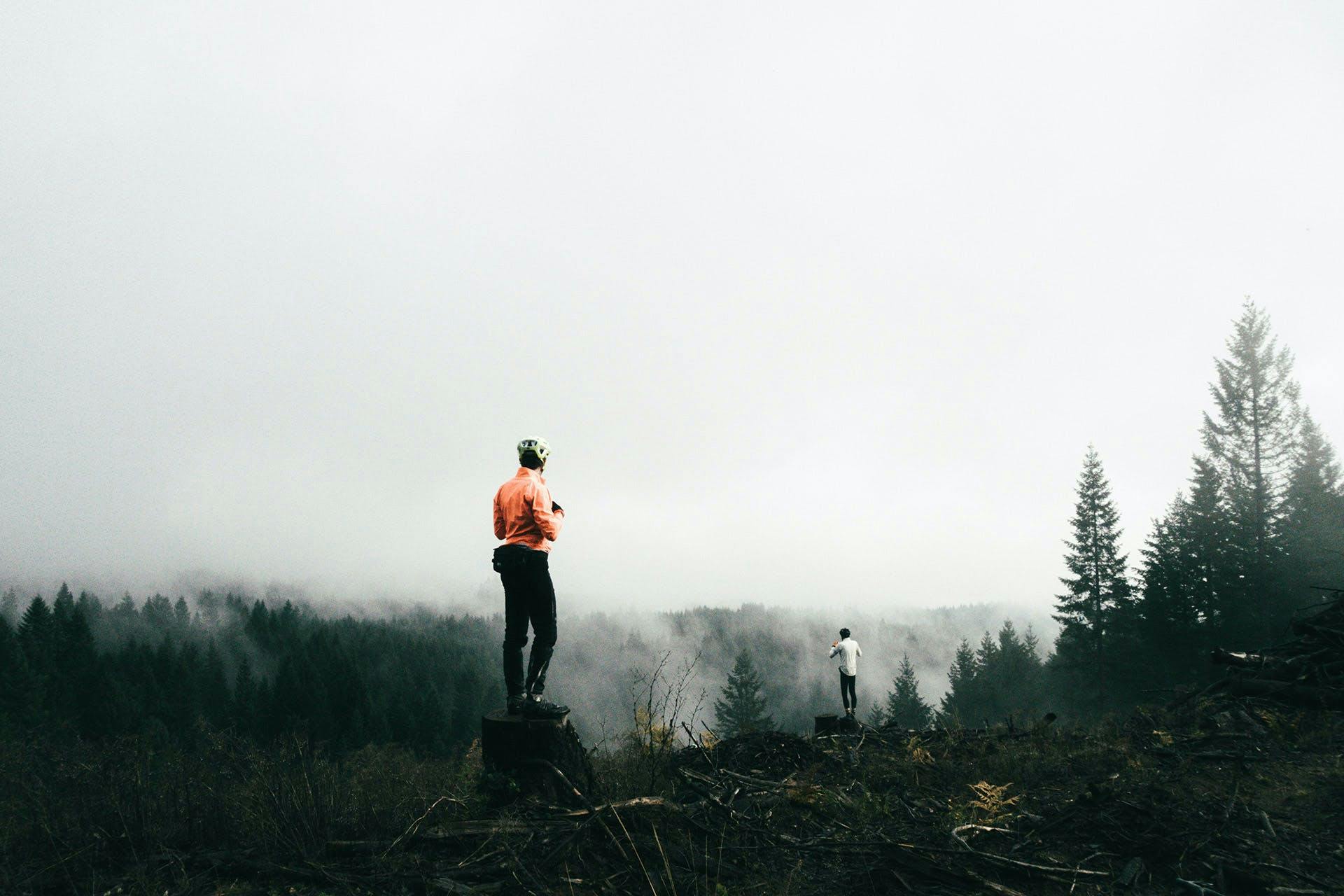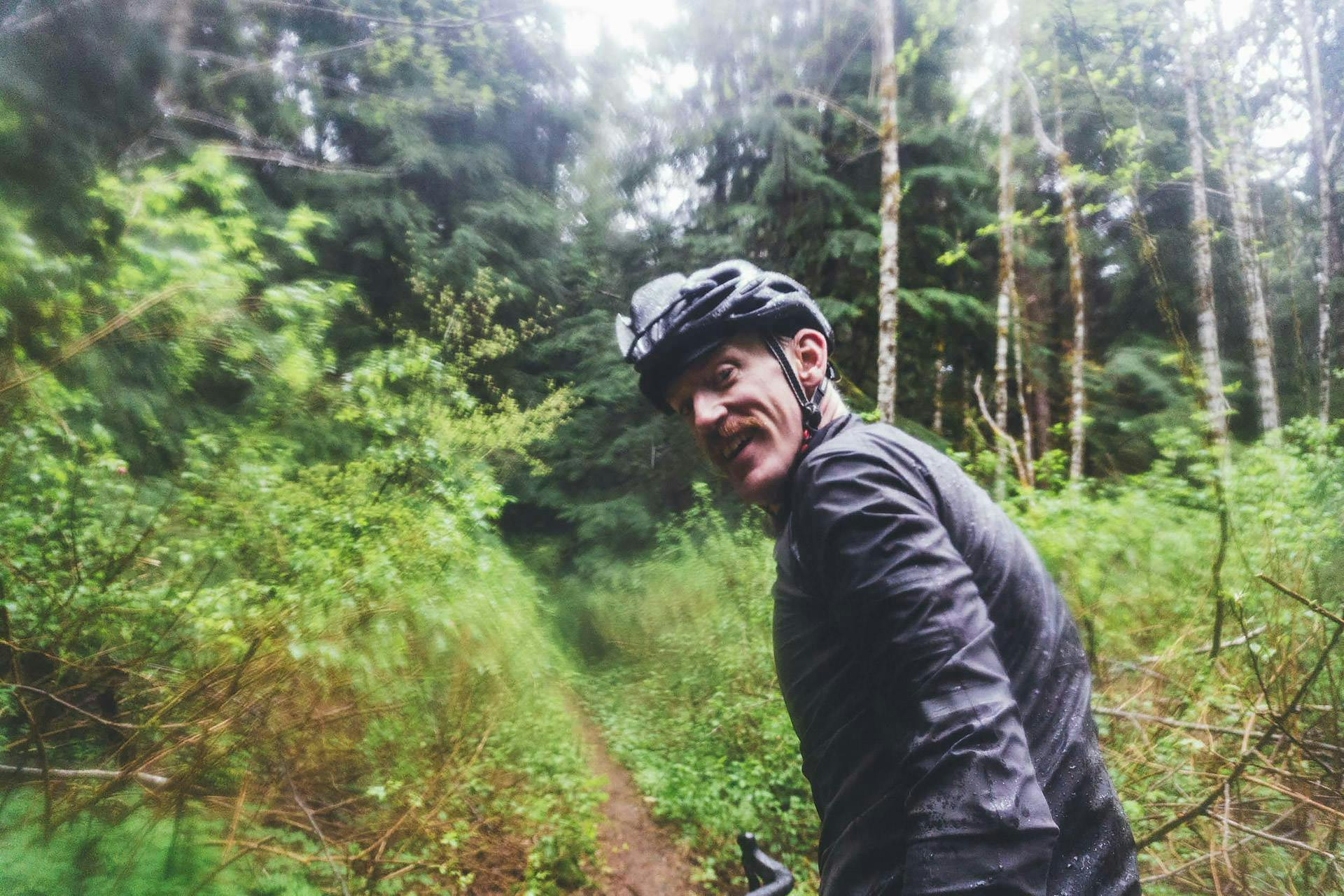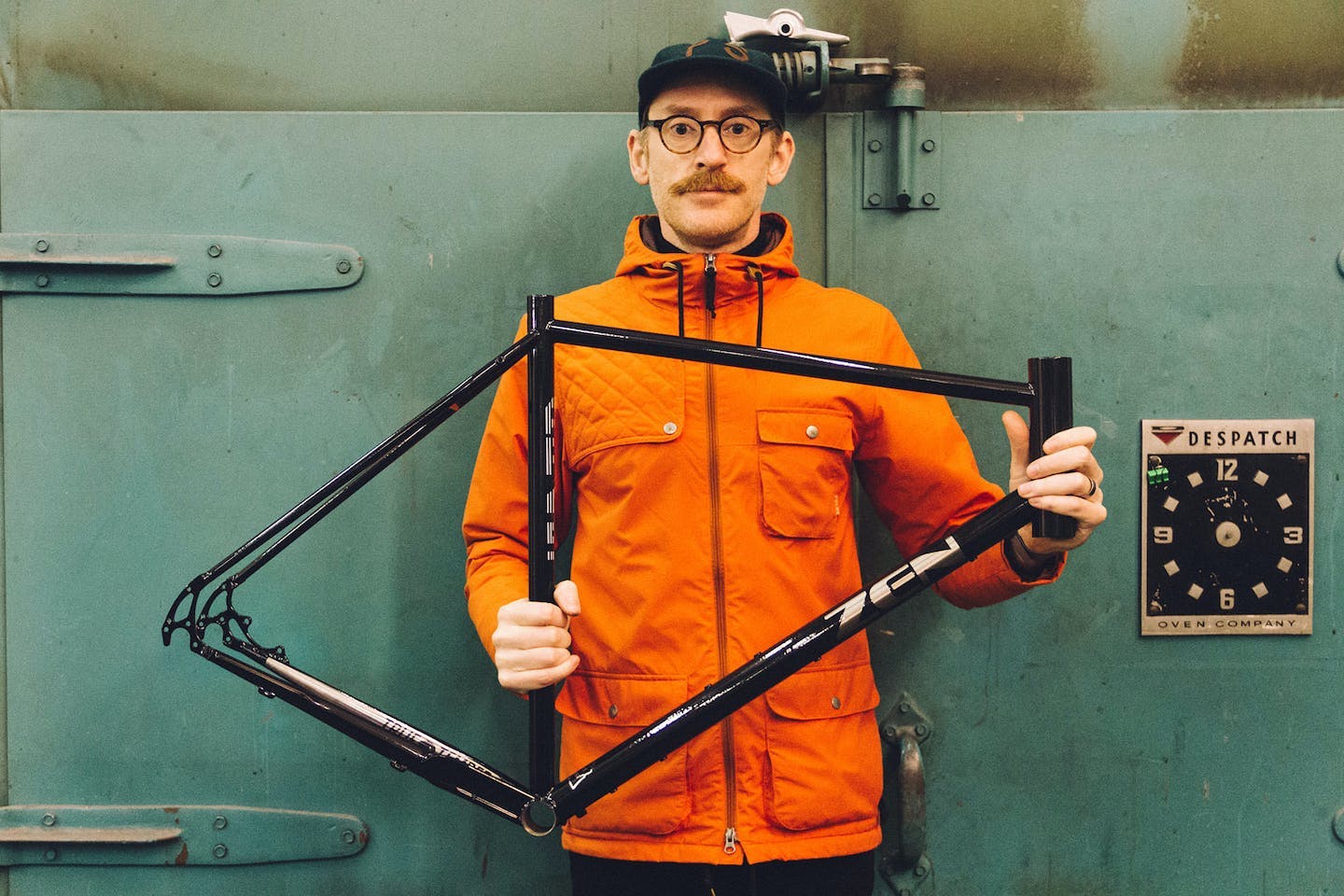The Routist: OMTM's Ron Lewis
Words: Pete Harrington
Photos: #1 OMTM, #2 Adam Kachman, #3 Christopher San Agustin
Most people who move to a new area make friends slow and steady. There’ll be a little coffee that turns into crullers and coffee, WhatsApps, a work lunch, and finally, the home dinner invite – the highest step on modern society’s ladder and a clear sign of congenial acceptance. Congratulate yourself!
Other people take a saw and machete to these societal norms – literally. Having moved from Seattle to Portland, Ron Lewis, one half of OMTM.cc and onetime bassist for The Shins, neatly sidestepped the chitchat, and got down to business as a semi-professional Routist, rolling the path less pedaled, and cataloging his findings alongside other OMTM-er Brandon Day for the benefit of gravel and groad riders everywhere. Well, at least in the Pacific Northwest. He may move again.
We sat down with this tall charming man for a little coffee of our own to find out about the routes and rides of OMTM.
Tell us a little about your fever for the gravel.
The first thing that made me catch the bug was when I broke my frame on an utterly unprepared ride way out past Otto Miller on some route that doesn’t even have a name. I was riding a Jim Miele steel road bike I’d found of all places, in a dumpster, although I was told by a mechanic that it was more or less in good shape. So there I was, riding solo way out in the wilds, when all of a sudden I started getting a peculiar feeling in my headset. I looked down, and there were crack points in the down tube and the top tube. And worse, I was lost, having taken a wrong turn at some point. Of course, I hadn’t yet started to ride with a GPS. That quickly changed.
You over-gravelled.
Yeah, just riding it above and beyond what it was ever intended or designed for.
Was that your first time heading out past known routes, or had you been leading up to that?
It was part of putting out the tendrils, reaching out and going further each time and figuring out where the roads went after I moved down to Portland from Seattle. Up there, everything is paved, with lots of highway interchanges, so you’ve got to go far out. It’s hard to ride from home and get to good adventure type stuff, so you end up having to drive out to places even to find the road climbs, like Issaquah and some of those spots.
Which is a bummer – if you’re riding, you’re riding.
Yeah, exactly. And here in Portland, in 10 minutes you’re up on Cornell Road and into all these interesting, wonderful places.
And so you found yourself going further and further, turning down paths and getting a bit lost, all the while exploring your new home?
That’s kind of how it started yeah. Me and my buddy Brandon Day got ‘cross bikes, and it unlocked things for us. We started racing cyclocross and doing weekend rides with our teammates, going out to Otto Miller and Dixie Mountain as the closest stuff that we knew. And we were having so much fun stringing together these routes, that we invited all of our cross teammates out to join us.

And you wanted to record the routes so you could more easily ride them next time?
Or just find or create some kind of database, cataloguing or index for other riders so that they could go out and enjoy a nice beautiful circuit without having to do all the trial and error. Because it sometimes takes five or six separate trips, trying different roads each time to see what’s the best loop and where everything goes. Often things that are on the map aren’t there in reality, or things have changed, or logging has affected an area.
So on the ground, it can often be very different?
Oh, very different, yeah. And so we rode with our teammates for a couple of seasons, and the further we were going with it the more our teammates started dropping by the wayside. They’d be like, “Nah, I got a race this Saturday. I’m sticking to my training schedule.”
Were you still racing at that point?
We did for a couple of seasons, Brandon and I. But the thing about cyclocross racing is you have to optimize your riding and your metabolism and your energy output precisely to the race format. And the people who were training for racing didn’t want to go that hard for that long because it wasn’t in their training regimen. “I got to stick to zone three for an hour and a half, and that’s what I can do,” and so on.
What the heck is zone 3?
I don’t even know. I was like, “we’re going to zone nine, man, come on!” Ironically, some of the best racers in the area will come out on our rides, and they don’t even really deal with that stuff, so it’s just a different psychology of the people who optimize and train by these dogmatic regimens.
And was part of the attraction of adventure riding to escape that mindset?
It was freedom from that and frustration with that. For me, it all came to a head three or four years ago when I rode the Cooper Spur Cycle Cross Race. The course was beautiful, but it was very challenging. Over on the east side of Mount Hood, there’s a lot of really crazy steep, soft and sandy stuff that can have you running if you don’t handle it right. I had a terribly frustrating race and fell into a bad mood. I don’t know if I came in last, but I was close to the bottom. Cooper Spur is right at the base of an incredible climb on one of the highest roads on Mt. Hood called Cloud Cap Road, which reaches above 6,000 feet. So I tore my number off, crumbled it up and in my frustration, decided to ride to the top.
Sounds like you rode yourself into the ground.
Yes, I think so. But as I kept riding it was enlightening. The further I got up there the further that stuff started to fade. I even ran into Kevin Purcell, who is now a pretty good friend of mine. He just opened the shop Golden Pliers with his partner Becky here in town. Anyway, I saw Kevin and his buddy Matt up there on these big burly adventure rides, drinking beers and eating gummy bears and just loaded down with snacks. I think there was pizza or something involved, too.
You were like, what’s this?!
A light bulb went off. There I was, all frustrated, and they’re just breezing up the mountain super fast on these big old bikes. I got up to the top of there and was so blown away by the scenery and the rolling viewpoints; how you could see from the east side of Hood all the way through the temperate rainforest stuff out into the agriculture sections of central Oregon. The contrast from the morning to the afternoon was incredible. And then I realised that I didn’t want to do that racing stuff anymore. I just wanted to have more and more of these experiences. Later on back down the mountain, Brandon and I were like, “oh, let’s do a website so we can catalogue this stuff”.
So then I started bringing a camera and iPhone along, trying to share the expansive beauty of these experiences, and illustrate how each route has a different flavour. All of which led to us writing them up and, if for nothing else, cataloging our experiences to help share the routes and get them out there so that other people would have a compendium of choices. Perhaps you’d like a hot central Oregon thing, or a nice misty rainforest experience this weekend. And the more that we were doing it, the more we racked up a catalog.
And how did the group rides come together?
That’s all down to my primary partner, Ryan Francesconi. Like me, he’s a reformed racer, and composer. I hadn’t met him before OMTM, but I knew his name from his work with Joanna Newsom, the folk artist. Ryan had been leading rides for years, but very informally, very unsanctioned, just getting together with buddies in the same niche that we were. So we hatched the idea to collaborate and started coming together on routes and inviting people and making these unsanctioned events out of them. We’re three years into that now, and that brought together a community of people because Portland is such a small cycling town.
From the amount of OMTM mentions around town, rides and on the internet, the concept seems to have galvanised people into trying gravel riding.
I think a lot of that has to do with happenstance. It was the timing of cyclocross bikes being widely available and the gravel and adventure things being widely marketed right around the same time. I mean, that’s how we got into it. People are like, “well, the racing thing isn’t necessarily my thing, but I can take this bike out on this amazing national forest road”. So I think a lot of people that get disenchanted with the discipline and the team structure of racing, find it very liberating.
Then we’ve got bikepacking and bigger clearances. It feels like we’re a hair’s breadth from hardtail mountain biking.
Well, the lines are blurring. We try to incorporate a lot of trails into our routes, not as a mountain bike type of endeavor but just as a way to mix up the terrain and do some paved stuff, some gravel stuff, some rutted out jeep trails, and then connect them back with singletrack. There’s no one bike, well, there didn’t use to be one bike that would work for all of that, and now there seems to be.

For anyone new to OMTM, can you talk about the difference between the routes and the rides?
The routes are more or less the circuits, loops and associated options we put together, photograph, write up and feature both on the website and in our Ride w/ GPS route library. Many of them were formulated as routes for specific events, as in the case of the Timber Logjam, Falls Creek Hinterland or Holy Mountain loops but the routing and information lives on the site thereafter for anyone to ride on their own at any time.
The events are social opportunities to ride specific routes with a larger group. We simply announce the date, time, starting location and provide the route link and anyone is free to show up and join us. They are always free. No registration is ever required. It is just a show-up and ride scenario. We will always provide as much helpful information as we can…bike and tire recommendations, water refill options, elevation gain…that sort of thing. But generally, they tend to be pretty loose and social. For the first two years, we did one event a month. Going forward we will be doing one each quarter, with the routing optimized and geared toward featuring the best of each particular season!
Monthly must have been a big undertaking.
Yeah and that’s when it took on its own thing. When we first started doing it, there would be 30, 40 or 50 people. But the very last one that we did, before we decided to go quarterly, there were almost 200 people, which is when it started to get very much outside of just our group of friends. So we’ve reduced the regularity for now and partnered up with HiFi wheels to share the burden of liability insurance. It’s still loosey-goosey, but we’re focusing on these quarterly things and trying to put more energy into fewer events, which frees us up throughout the rest of the year to explore and try new things.
How do you get started with a route?
The first place to start is just looking at the map and asking people for recommendations, and feedback if they’ve ridden in these areas before. The next step is to get out there, often several times to conclude a route, which at its most extreme, can see Ryan and I opening up dying abandoned trails with saws and machetes that we carry as we ride.
…trails that no one has been along for potentially decades?
A lot of the trails that we try to find and link up with are like that – old trails that not many people ride anymore. We try to avoid some of the major trails systems just because, well, that’s standard mountain biking, and, already known.
What’s the perfect bike for OMTM riding?
People ride just about anything and everything. It started out, the joke was always like, “can I ride 28s on this”? We would add disclaimers like, no, don’t show up on road cleats, don’t show up on 28s. Now, with (All City) Gorilla Monsoons and Surly having clearance for bigger tyres and all the Crust bike stuff having plenty of room, everybody seems to be making a really wide tyre 650B kind of adventure-based machine.
Mountain bike-lite.
Yeah! We have a buddy who’s a frame builder, Chad Smeltzer – great guy, super strong rider – he’s a custom steel frame builder, and we collaborated with him on what would be the ideal bike for OMTM riding. And we built it with him.
Sweet.
It’s called the Gifford because the Gifford Pinchot National Forest up in Washington on the other side of the Columbia is one of our favourite places to ride.
What’s the spec?
Well, we patterned it off of a few different types of bikes. But it ended up being built around a 650B wheelset with Columbus Life tubing, which is what I think Breadwinner use for their Hole Shot and G-Road bikes. It’s a very lightweight, very high-quality ride with a generator front hub for front and rear lights – the works. Anyway, it’s Ryan’s bike now, and he loves long days, and I mean 200 miles with 13,000 ft of elevation. And with those distances, it had to be very performance-oriented but also very, very sturdy with lots of cargo capacity for when he rides to the shops. Mountains and melons. It was fun to walk through that process and see it all come together and learn about the wiring and the generator.
On a tangent, do you notice any similarities between your musical career, and the process of scouting, riding and plotting these routes?
Oh, yeah, absolutely. It’s funny, the fact that Ryan and I are both composers. I don’t race, but I like putting together routes. That’s my creative outlet because I’m a composer and not really a performer. Which is analogous to putting together the routes, envisioning the stuff and then handing it off for somebody else to ride. The cycling community in Portland, perhaps because it is such a small city, reminds me of the music and creative communities; frame builders and racers and enthusiast and bike packing scrappy party hippies and all kinds of fun people who are all thrown in together with a common focal point.
And was that a surprise to you when you started doing it, that you found something new that you could relate to?
Yeah, because I toured for years and it’s a very unhealthy lifestyle, and not particularly sustainable for a lot of people. So I’d come back from tours having smoked a lot of cigarettes and drunk a lot of beer and eaten very unhealthy on a lot of late nights, and I used cycling as a way to get back to some semblance of fitness after tours. Eventually, they just crossfaded and I didn’t want to do the travelling thing anymore but this cycling thing, that was good. That was something.
